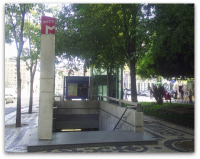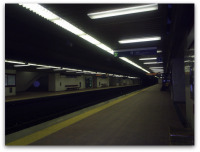
Lisbon Metro (Subway)Lisbon Metro (Subway) is the fastest way to travel through Lisbon. It is a reliable transportation with several trains during the day. For me it has an inconvenient: you don't get to see the view while you're travelling. And don't forget to read my safety tips. The first project was created in the year of 1888. It was designed by Henrique de Lima e Cunha and already included a net of underground railways. It didn't pass the paper stage. Later, in the beginning of the past century (XX) two other projects were developed by Lanoel d'Aussenac / Abel Coelho (1923) and José Manteca Roger / Juan Luque Argenti (1924). They also didn't succeed. It was only after the World War II, with the precious help of the Marshal Plan funds, that the decision of building the Lisbon Metro was finally made. So, in the year of 1948, the Metro Company was created. We had to wait until the year of 1955 for the construction to begin. Please, remember that in those days we were not running as much as we do now! And the drawings were probably hand made. Know what I mean? Lots of rubber erasers and stuff... After only four years, we were celebrating the Lisbon Metro inauguration. It was a major success. In the first year some 15,3 million passengers used the subway.  The network originally had two lines: The network originally had two lines:
At the time of the inauguration, the Lisbon Metro was the Europe's 14th and the world's 25th. The first ever was the London Subway designed by Charles Pearson, the inventor of this kind of transportation. From those days until now, the Metro Network has grown to four lines and 46 distinct stations divided this way:
If you would like to know more about how the metro network grew over the years just click here. The following stations are common to more than one line:
Under construction are the following connections:
 When
ready, Lisbon will have 40
Km of
underground
railways divided by 4
lines and 52
subway stations. When
ready, Lisbon will have 40
Km of
underground
railways divided by 4
lines and 52
subway stations. Almost all of the Metro Stations are authentic art galeries, like for example the Orient Station. You have to see them with your own eyes. Don't forget to check out the Metro Network Diagram and the Subway Map. You can also save or print them. Top
of Page |
|

